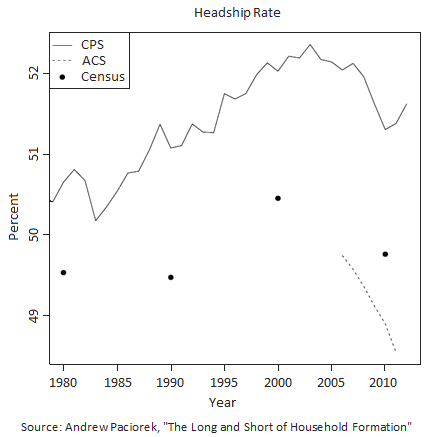In our discussions with real estate builders and developers, we often hear about references to trends in household formations. The prevailing sentiment seems to be that while household formations were tempered during the downturn, they are bound to pick back up any time now. More importantly, this belief is often cited as justification for ramping up acquisition and development activities.
After hearing numerous contacts cite their expectations for resurgence in household formations, we began to wonder more about the underlying trends. Have recent household formation dynamics fundamentally shifted from the long-run trend? Or have dynamics been stymied only temporarily before they eventually bounce back to the longer-term trend? And what effect will this bounceback have on housing demand?
To better understand these dynamics, we invited Andrew Paciorek, economist at the Federal Reserve Board of Governors, to discuss with staff and leaders from the business, civic, and not-for-profit communities his recently published working paper on the short- and long-run trends in household formation. (You can see his presentation on the Atlanta Fed website.)
Before jumping into the findings on trends in the data, it seems appropriate to acknowledge that the data come from three main sources at the Census Bureau: the Current Population Survey, the American Community Survey, and the decennial censuses. (See the chart below from the full presentation available here.) While each source has its strengths and weaknesses, the important takeaway is that they all tell a different story when viewed in isolation. This gives me some cause for concern when I think about trying to use these data alone as support for making development decisions.
Paciorek's research aims to isolate the drivers of household formation and, once they are better understood, use them to make an informed forecast about trends going forward. So, jumping now to the takeaways on the drivers of household formation, Paciorek finds that demographics (primarily aging) contribute the most to increases in household formation over the long run. Education and income, as well as rental costs, are also found to influence the decision to form a household. In the short run, rental costs, employment status, and income matter the most for decisions to form households.
With that as context, let's look back at the data. From 2001 to 2006, approximately 1.35 million new households were formed each year. Then from 2006 to 2011, the number of household formations dropped to 550,000 each year. Paciorek predicts that if the projected population growth of 2.2 million per year is achieved, we can expect 1.5 to 1.6 million new households to form each year. However, he gives an important caveat: there remain frictions. For example, the restricted availability of credit could temper spikes in household formations over the short run.
Paciorek's forecast is dependent on other data points materializing, but his prediction supports the idea that there will be a bounceback to, and possibly even above, the longer-run trend in household formation. If that bounceback is achieved, we could definitely expect to see an increase in housing demand. Perhaps our industry contacts are positioning themselves well after all.
We invite you to watch a video of the talk that Andrew Paciorek gave on June 24 and to contribute to the conversation by posting your comments below.
 By Jessica Dill, senior economic research analyst in the Atlanta Fed's research department
By Jessica Dill, senior economic research analyst in the Atlanta Fed's research department



